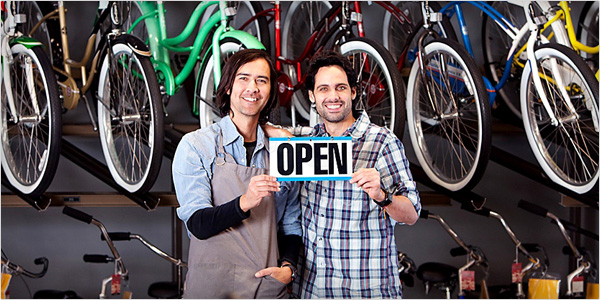Hyper-local marketing is still a relatively new buzzword, but the concept is as old as business itself. When someone first posted up on a street corner and started hawking their widgets, they were practicing hyper-local marketing. These days it’s a bit more complicated than being able to shout the loudest: customers search for businesses online, find their way to the store with their phone, and rely on reviews to make purchasing decisions.
Hyper-local marketing, then, is an approach to managing the messaging that gets customers to walk down the street and through your door. How do you make sure that when someone pulls out their phone and searches “coffeeshop with wifi,” your business will show up on their map? What steps can you take to ensure that your online reputation matches the excellent services you actually provide?
The strategies of hyper-local marketing range from simple to complex, but this guide will get you started with the basics for your small business.
Get Noticed: Simple Steps to Hyper-Local SEO
One of the biggest hurdles to clear in staying relevant in an increasingly online and mobile-driven world is simply getting noticed at all. If you don’t show up on someone’s map app of choice, or when they press “search in this area,” they’re never going to be aware of you— let alone walk in the door.
According to local SEO experts, 82% of local searchers follow up, either on the phone, visiting the store, or making a purchase. How can you boost your local ranking? It’s not enough to make sure that your Google+ account is up-to-date, because Google and other search engines look at a number of factors to generate search results. They take into account both how many times something is listed, and whether or not the information in each listing matches.
Make sure you have your NAP (Name, Address, Phone Number) listed, verified, and matching across as many services as possible. It might be time-consuming and repetitive, but it’s free and essential to a good ranking. The most popular beyond Google include Yelp, YP, Dexknows, Yellowbook, and TripAdvisor.
For a more about managing your listing, take a look at Convince and Convert’s helpful guide.
Stand Out: Why Reviews Matter
Reviews can be a source of a lot of anxiety for small business owners. It’s easy to feel like one bad review can destroy your reputation and make a serious dent in your profits. We’ll get into how to deal with bad reviews in a moment, but first let’s look at why reviews are so important in the first place.
Word of mouth is always discussed as the biggest source of customers for local businesses, and for good reason. However, online reputation is quickly catching up as mobile continues to increase and millennials become an even larger segment of consumers. According to BrightLocal’s Consumer Review Survey, 88% of customers trust local reviews as much as in-person recommendations.
Reviews are also an important factor in local search ranking. A Moz survey showed that reviews account for 10% of local search ranking, and as we discussed, local SEO is key to driving in-store traffic.
In light of all of this, it’s important to take steps to get as many reviews as you can. A few simple steps can go a long way. Make sure that you are linking to your Yelp and Google profiles anywhere you can: your website, your loyalty or business cards, or on any emails you send out. If you use a digital POS like Square or TouchBistro, take a moment to customize the email receipt to include a blurb about reviews.
Another old-school approach is to offer something in exchange for reviews. Get creative! You could enter reviewers in a raffle, offer a small discount, or even hold a special event.
Take Charge: Managing Your Reputation
The truth about having an online presence is that bad reviews are going to happen. No matter how excellent your service or product is, or how great a customer experience you provide, at some point someone is going to have a bad day, have bad luck, or simply come in the door with unrealistic expectations.
The key, according to Perch, is to “consider any response to a negative review a marketing message to your prospective customers.” Yelp, Google, and other social media platforms offer a great opportunity to show that you are responsive to concerns, and fix problems in a public way. This communicative approach is key to successful hyper-local marketing.
As in any other customer service situation, it’s important to take the time to acknowledge a bad experience, take responsibility for it, and then show that you are willing to take action. Even if the criticism is unreasonable, it doesn’t cost you anything to say that you’re sorry they had a bad experience. Remember that you’re actually writing to everyone else who is reading the review, not just the person who wrote it. It’s more important to show that you are responsive and well-intentioned than to argue about who was right or wrong.
Step Up: Offer a Great In-Store Experience
Remember, once you get the customer in the door, you still need to offer a great experience. The advantage that local small businesses have over national and internet-based behemoths is the opportunity to offer a unique and personalized environment.
One thing to help you stand out is to take advantage of the ways you can integrate technology into your approach. In-store WiFi should be a given. Not only does it offer something of value to your customers, but it also gives you a chance to collect information useful in a number of ways.
Make sure to keep abreast of any apps or other technology that can help you create a more seamless experience. Are there ways you could minimize wait times, make payment easier, or even simply publish your menu or services in an easy-to-find place?
Data from WiFi and other customer service apps can help you make changes to your layout, adjust your pricing, or identify what brings people through the door in the first place.
What You Can Do Right Now
It’s still relatively early in terms of how hyper-local marketing, social media, and other strategies come together. While the landscape is always shifting, the basics of a hyper-local strategy are simple:
-
Get noticed by making sure you are listed across a number of platforms and that all of your information matches
-
Stand out by finding ways to encourage customers to write reviews for your business
-
Take charge of your reputation by viewing each response to a negative review as a marketing opportunity
-
Step up and use technology to offer a great in-store experience
- How to Use Business Technology to Thrive in the Future of Hybrid Work - October 19, 2021
- The Breach Within – How to Address the Risk Employees Pose to Your Cybersecurity - September 9, 2021
- The Future of Remote Work and How Collaboration Is Evolving - August 30, 2021


